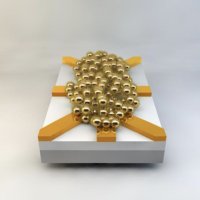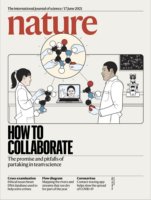Materials that we would call ‘intelligent’, what do we mean by that? Are we referring to the manufacturing process, do these materials have cleverly invented properties? Or will we have matter that feels, gives feedback, communicates and remembers? Materials that enable us to, for example, develop a computer brain that is as efficient as our own. In their paper ‘The rise of intelligent matter’, researchers of the universities of Münster and Twente, explore the possibilities. This paper is in Nature of 17 June.
Memory metal is a material we’ve known for a long time. It takes its original shape at the moment conditions like temperature return to their original value. Or think of piezo material: it changes shape when an electric voltage is applied, or it gives an electrical signal if it is under pressure. These clearly are more than the average ‘structural’ materials, we’ll often call them smart.
Still, the German-Dutch research team would like to know if we can go much further, truly attributing intelligence to a material. Are we capable of creating an artificial brain that works as efficient as our own brain? Can we create soft robots based on the intelligent tentacles of an octopus? In Nature, the researchers explore the possibilities.
Four main characteristics
The paper first defines what would be needed for calling material intelligent. Alright, it will not have a will of its own, it will lack cognition, but what it should do is feel, communicate, give feedback, store information and act. In technical terms: it would need sensors, actuators, communication technology and memory. And all of that united in one material, independent of some sort of central controller. The University of Twente already developed tiny sensors that act on their own like a swarm of living creatures, communicating autonomously. Still, every sensor is a miniature conventional computing system. The challenging question is if it is possible to create matter that unites all of these properties.
Connection and memory at the same time
 Prof Wilfred van der Wiel, one of the authors, works on radically new computer concepts based on the functioning of our brain. He co-directs the Center for Brain-Inspired Nano Systems at the UT. Earlier on, he demonstrated that disordered structures, consisting of gold particles or silicon atomic networks, are capable of detecting patterns, using an evolutionary way of learning (Nature, January 2020). One of the challenges is equipping such a network with memory. Not in the classic way computers work, continuously pumping data between the processor and the memory. Our brain works far more efficient, and Van der Wiel has his ideas about mimicking this. “The chemical connections inbetween the gold nanoparticles, avoiding short circuit, should ideally also serve as a memory. That’s what we are currently working on.” Taking this some big steps further, you could even philosophise about ways of connecting artificial brains to living brains in the future.
Prof Wilfred van der Wiel, one of the authors, works on radically new computer concepts based on the functioning of our brain. He co-directs the Center for Brain-Inspired Nano Systems at the UT. Earlier on, he demonstrated that disordered structures, consisting of gold particles or silicon atomic networks, are capable of detecting patterns, using an evolutionary way of learning (Nature, January 2020). One of the challenges is equipping such a network with memory. Not in the classic way computers work, continuously pumping data between the processor and the memory. Our brain works far more efficient, and Van der Wiel has his ideas about mimicking this. “The chemical connections inbetween the gold nanoparticles, avoiding short circuit, should ideally also serve as a memory. That’s what we are currently working on.” Taking this some big steps further, you could even philosophise about ways of connecting artificial brains to living brains in the future.
Octopus
The ‘perspective’ paper explores several options for intelligent materials. In soft robotics, for example, we could learn a lot of the octopus and its tentacles: it is well-known that the intelligence is inside the arms as well. Detecting if more pressure is needed, is immediately followed by action, in a flexible way. Soft robotic arms, created in this way, can avoid the use of bulky and heavy metal structures. Or, take our own skin as an example, capable of adapting to changing circumstances fast and having strong self-healing properties.
Lessons From AND about life
The authors describe first examples of materials that are adaptive and responsive: the basic features for intelligent materials. Including all properties, for example by introducing new nano elements in a material, is a huge challenge with sometimes self-contradictory constraints. Still, for a new approach of artificial intelligence, the materials have a lot of potential. And, as they are highly bio-inspired and bio-compatible, they teach us a lot about ourself in turn.
The Nature paper is the result of the collaboration ‘Intelligent Matter: from responsive to adaptive nanosystems’. This is a ‘Collaborative Research Centre’ for which German government assigned 10 million euro. Wilfred van der Wiel, apart from being Professor of NanoElectronics at the University of Twente, is also a Professor at the University of Münster.
 The rise of intelligent matter, by Corinna Kaspar, Bart-Jan Ravoo, Wilfred van der Wiel, Seraphine Wegner and Wolfram Pernice, is in Nature of 17 Jun 2021.
The rise of intelligent matter, by Corinna Kaspar, Bart-Jan Ravoo, Wilfred van der Wiel, Seraphine Wegner and Wolfram Pernice, is in Nature of 17 Jun 2021.





